Traditionally, you would go to the fuel station to purchase your fuel with cash in your hand. But in this new era, technology, and innovations in the fintech sector have made transactions seamless. Many businesses have accepted the used fuel cards, which simplify fuel purchases and significantly reduce overheads and reconciliation.
The Benefits of Using Fuel Cards for Your Business
Using a fuel card for your business can provide several advantages that can streamline operations, reduce costs, and increase overall efficiency. One of the primary benefits is the ability to save money on fuel expenses. A fuel card program offers discounted rates at participating fuel stations, allowing you to stretch your fuel budget further. Additionally, fuel cards eliminate the need for employees to carry cash or personal credit cards, reducing the risk of misuse or fraud. Another significant advantage of fuel cards is their enhanced management and control over fuel expenses. Most fuel card providers offer detailed reporting and tracking features, allowing you to monitor fuel consumption, identify potential areas for cost savings, and enforce fuel policies. This level of visibility and data analysis can help you make informed decisions about your fleet’s operations and optimize fuel efficiency.
Furthermore, fuel cards can simplify the administrative tasks associated with fuel purchases. Fuel transactions are consolidated into a single, itemized invoice, eliminating the need to deal with piles of receipts and reimbursement requests. This streamlined process not only reduces paperwork but also saves time and improves accuracy in record-keeping and expense reporting.
Choosing the Right Fuel Card Provider for Your Business
When selecting a fuel card provider for your business, it’s crucial to consider several factors to ensure you make the right choice. First and foremost, evaluate the provider’s network coverage and the number of fueling locations they offer. Those providers with a large network can provide their drivers with convenient access to fuel stations, reducing possible downtime and increasing efficiency. The next thing to look out for is to compare the pricing structures and potential discounts offered by different providers. Never lose sight of competitive per-gallon rates, as well as any additional savings or rewards programs that could further reduce your fuel costs. Make sure to scrutinize all options and steer clear of those that impose significant transaction fees or monthly charges, as these could significantly affect your overall expenses.
Being a cashless way of purchasing fuel, it is important to work with providers with reporting and tracking capabilities because robust reporting tools can help you monitor fuel consumption, analyze spending patterns, and identify areas for cost optimization, as your business really depends on them. For example, a provider must offer detailed reporting options, including online account management and real-time data access.
Security and fraud prevention measures should also be a priority when choosing a fuel card provider. Inquire about their security protocols, such as PIN or biometric authentication, and their processes for detecting and preventing fraudulent activities. You should evaluate the provider’s customer support and overall reputation. Look for companies with responsive and knowledgeable support teams, as well as positive reviews and testimonials from other businesses in your industry.
Tips for Maximizing Your Fuel Card Savings and Efficiency
As a business, you should take any available opportunity to cut costs and save money. If you have the right strategy, you can save a significant amount of money with your fuel card. If you’re still unsure, consider these tips to optimize your fuel card savings and efficiency:
1. Implement a comprehensive fuel card policy that outlines permitted and prohibited purchases, driver IDs, vehicle IDs, and other controls. Clearly communicate this policy to all drivers.
2. Regularly analyze your fuel card data to identify savings opportunities. Look for unusual transactions, out-of-policy purchases, excessive idling, and inefficient routes or driver behaviors.
3. Leverage fuel card reporting and analytics tools to gain visibility into your fuel spend and pinpoint areas for improvement. Set benchmarks and track progress over time.
4. Based on your projected spend, negotiate volume-based discounts with fuel retailers. Consolidating purchases with a few preferred vendors can lead to significant savings.
5. Automate expense management by integrating your fuel card program with other systems like GPS tracking, accounting software, and maintenance programs. This streamlines processes and provides a comprehensive view.
6. Implement fuel-efficient policies such as anti-idling laws, speed limits, and route optimization. Educate drivers on practices that reduce fuel consumption and costs.




GIPHY App Key not set. Please check settings